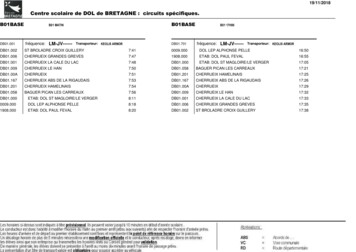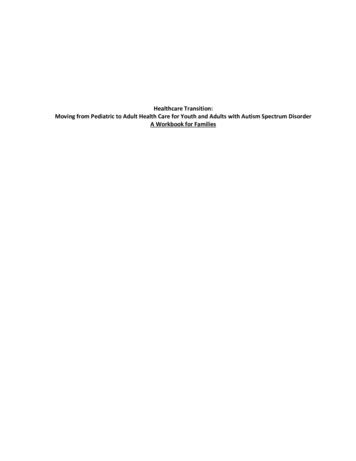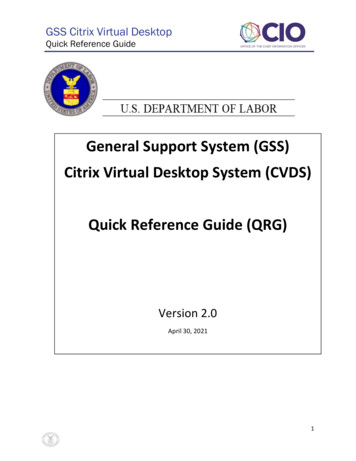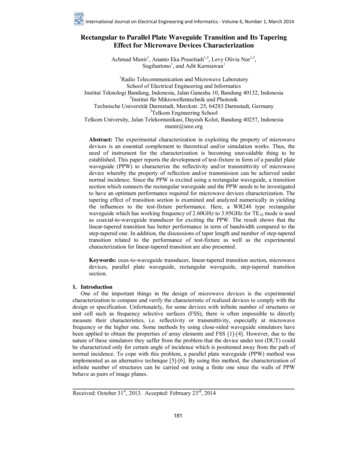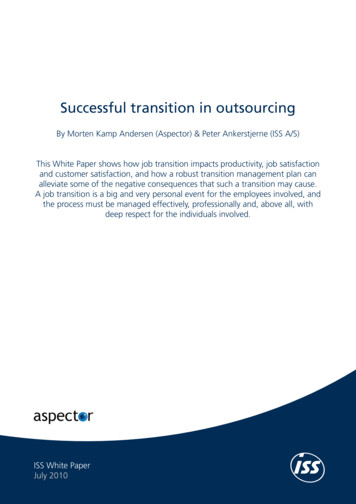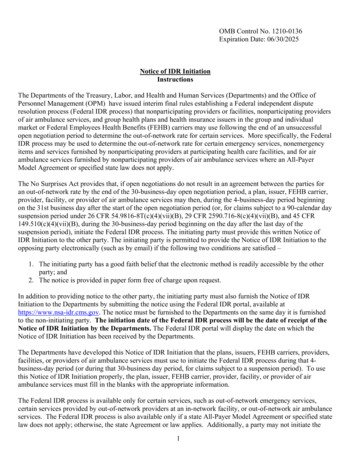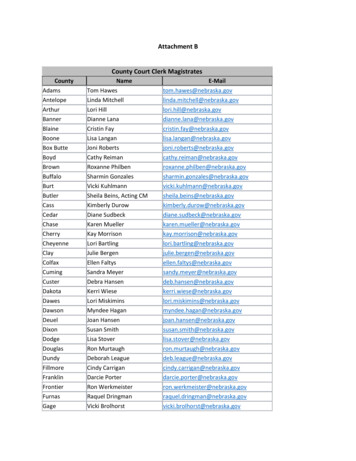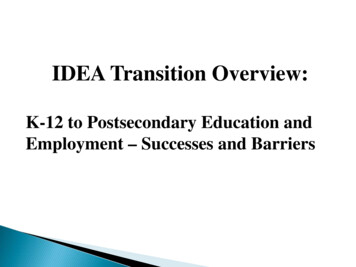
Transcription
IDEA Transition Overview:K-12 to Postsecondary Education andEmployment – Successes and Barriers
To ensure that all children with disabilities haveavailable to them a free appropriate publiceducation (FAPE) that emphasizes specialeducation and related services designed to meettheir unique needs and prepare them for furthereducation, employment and independent living. [34 CFR 300.1(a)] [20 U.S.C. 1400(d)(1)(A)]
Beginning not later than the first IEP to be ineffect when the child turns 16, or younger ifdetermined appropriate by the IEP Team, andupdated annually thereafter, the IEP must include: Appropriate measurable postsecondary goalsbased upon age-appropriate transitionassessments related to training, education,employment and, where appropriate,independent living skills;
The transition services (including courses ofstudy) needed to assist the child in reachingthose goals; and Beginning not later than one year before thechild reaches the age of majority under Statelaw, a statement that the child has beeninformed of the child’s rights under Part B , ifany, that will transfer to the child on reachingthe age of majority under §300.520[34 CFR 300.320 (b) and (c)]
A coordinated set of activities for a child with adisability that – Is designed to be within a results-orientedprocess, that is focused onimproving academic and functionalachievement to facilitate the child’s movementfrom school to post-school activities,including
Postsecondary education, Vocational education, Integrated employment (including supportedemployment), Continuing and adult education, Adult services, Independent living, or Community participation;
Is based on the individual child’s needs, takinginto account the child’s strengths, preferences,and interests; and Includes instruction, related services,community experiences, the development ofemployment and other post-school adult livingobjectives, and, if appropriate, acquisition ofdaily living skills and provision of a functionalvocational evaluation.[34 CFR 300.43 (a))] [20 U.S.C. 1401(34)]
Transition services for children with disabilitiesmay be special education, if provided asspecially designed instruction, or a relatedservice, if required to assist a child with adisability to benefit from special education.[34 CFR 300.43 (b)]
The LEA must invite a child with a disability toattend the child’s IEP Team meeting if a purposeof the meeting will be the consideration of thepostsecondary goals for the child and thetransition services needed to assist the child inreaching those goals [34 CFR 300.321(b)] [20 U.S.C. 1414(d)(1)(B)]
to the extent appropriate, and withconsent, [the LEA] must invite arepresentative of any participating agencythat is likely to be responsible for providingor paying for transition services to attendthe child’s IEP Team meeting.[34 CFR 300.321(b)(1) and (3)] [20 U.S.C. 1414(d)(1)]
a public agency must provide the child withsummary of the child’s academic achievementand functional performance, which shall includerecommendations on how to assist the child inmeeting the child’s postsecondary goals.34 CFR 300.305(e)(3)
June 2012 – OSEP’s response to SpitzerResnick, Swedeen, and Pugh – Work placement can be an appropriatetransition service, depending on the individualneeds of a student, but is not a requiredcomponent of all IEPs that address transitionservices.
According to the LRE requirements in IDEA,each public agency must ensure that - To the maximum extent appropriate, childrenwith disabilities, including children in publicor private institutions or other care facilities,are educated with children who arenondisabled; and
Special classes, separate schooling, or otherremoval of children with disabilities fromthe regular education environment occursonly if the nature or severity of thedisability is such that education in regularclasses with the use of supplementary aidsand services cannot be achievedsatisfactorily.
Placement decisions, including those related totransition services (including work placement),must be based on these LRE principles andmade by the IEP Team. IDEA does not prohibit segregatedemployment, but the LRE provisions wouldapply equally to the employment portion of thestudent’s program and placement.
Seattle University - Center for Change in Transition Services,2010
After graduation from HS, Lissette will attendthe Workforce Development Program andcomplete a non-degree program in foodservice at Montgomery Community College After high school, Lissette will participate inweekly instruction on independent living skillsat the local Independent Living Center in hercommunity
After HS, Lissette will work on campus parttime in the food court at the college withsupports from VR and the staff at the college. After completion of the WorkforceDevelopment Program, Lissette will work as aprep cook at a local restaurant with timelimited supports provided by the PennsylvaniaAssociation for Individuals with Disabilities
Upon completion of HS, Lissette will utilizepublic transportation, with time limitedsupports provided through VR. After HS, Lissette will live semiindependently with a roommate in an assistedliving apartment with supports providedthrough Disability Services.
Education and Training Instruction Instruction on Community Safety skills Travel instruction Math instruction related to money usage Literacy instruction related to sight wordidentification Instruction on community safety and selfdefense at the YMCA
Related Services Assistive technology services to increase useof voice output device Physical therapy to improve ambulationEmployment & Other Postschool Living Obj. Purchase a monthly bus pass Learning to use the pull cord to identify herupcoming bus or trolley stop
Lissette and her Parents The High School Employers The Independent Living Center The Vocational Rehabilitation Agency The PA Association for IWD The Montgomery County CommunityCollege’s Workforce Development Program
National Technical AssistanceCenter on Transition(NTACT):Improving Postsecondary Education andEmployment Outcomes for All Students withDisabilitiesThe Center is funded for 2.5 million per year as acollaborative effort with OSEP and RSA beginning January1, 2015 and ending December 31, 2019.David W. Test, PhD, Project DirectorUniversity of North Carolina at Charlottedwtest@uncc.edu
To assist State Education Agencies, LocalEducation Agencies, State VR agencies, andVR service providers to implement evidencebased and promising practices ensuringstudents with disabilities, including thosewith significant disabilities, graduateprepared for success in postsecondaryeducation and employment.
University of North Carolina at CharlotteUniversity of OregonWestern Michigan UniversityUniversity of KansasTransCen, Inc. and a cast of many content expert advisors
Increased access/participation in rigorousacademic preparation so students are preparedfor success in postsecondary educationIncreased access/participation in career-relatedcurricula so students are prepared for postsecondary employment and careersImproved quality of secondary transition servicesIncreased use of data-driven decision-makingIncreased knowledge/implementation ofstrategies, including early warning andintervention systems, to reduce drop out andincrease graduation
PredictorEducationEmploymentCareer Awareness*Community Experiences*Exit Exams/High School Diploma StatusXXXXInclusion in General EducationInteragency CollaborationOccupational Courses*Paid Employment/Work Experience*Parental ExpectationsParental InvolvementProgram of ependent LivingSocial SkillsStudent SupportTransition ProgramVocational Education*Work Study*XXXXXXXXXXXXXXXXXXXXXXXXXXX27
Type of WBLECareer ExplorationJob ShadowingWork SamplingService LearningInternshipsAudiences:Schools, Businesses, Youth Services Professionals, Families, Youthwith DisabilitiesFor each audience and type of WBLE the websitecontains materials on how to do it, as well asexamples of how the WBLE is being done in schoolsand communitiesApprenticeshipsPaid EmploymentMentoringYouth to Work Coalitionhttp://www.nsttac.org/ytw/home
funded 50% by school and 50% by VRbegins working with freshmen and provides follow alongservices until the student reaches the age of 25provides an array of work exploration activities, such asjob shadowing, informational interviews, community basedassessments, unpaid work experiences, and assistingstudents in getting paid work experience prior to highschool exitworks closely with VR, parents, and school staff to ensurealignment of activities, including connection to course ofstudyoriginally started in the 90s, approximately six years agoprogram was redesigned for earlier student engagementand to increase connections between partnersrehab rate is typically close to 80%, average hours worked35, and wages about 10/per hour
originally funded through a systems change grant,the project was designed to help the state discoverwhat type of supports, resources, etc., it would taketo build an effective employment preparationprogram in a school districtfive school districts were selected based on theirdata, relationship with VR, and their willingness toparticipatein each site the high school was asked to take thelead to identify, coordinate, and engage communitypartnersschools have been working on their model for the lastthree years and each site has seen an increase in thenumber of students getting paid work experienceprior to exiting high school
Having administrative buy-in (e.g., shared vision andresponsibility for student outcomes)Understanding roles and responsibilities of each partner(e.g., flow of services document; implementationinfrastructure - how to organize the work, how tocommunicate among partners, how to coordinate workwith student)Using data - both systems and individual student – tohelp teams understand how to use data to impactprogram improvementRealizing one-model doesn't fit all - each community isunique and composition of school teams look different
Needing technical assistance with implementing, problemsolving, and field- based training on effective employmentdevelopment strategiesExamining current curriculum and aligning course contentand skill development with local work force needsOffering summer work experience program( e.g.,partnering with community college as intermediary for asummer work exploration program)Realigning school work experience coordinator’s timefrom part-time to full-time & allowing for flexible aschedule to accommodate night and weekend support ofstudent in jobsDesigning programs to result in seamless transitions fromhigh school to careers
Evidence-based predictors for employmentskills df/ebps/Predictor SelfAssessment.final 06 24 13.pdfYouth to Work Coalition Work-based learning resources for schools,businesses, youth service professionals, families ,and youth with disabilities http://www.nsttac.org/ytw/home
Thank you!
education, employment and independent living. . Education and Training Goals; Employment Goals; Independent Living Goals; Examples of Transition Services; Key Partners; National Technical Assistance Center on Transition; NTACT; NTACT's Purpose; NTACT's Partners; NTACT's Outcomes; Transition Alliance Program; TAP; Model Employment Transition .
